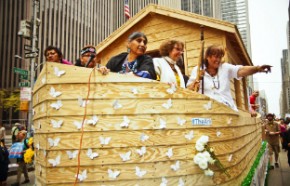Prayers with feet: Faith and hope at the Peoples Climate March
Noah’s ark lurched and started. An inflatable mosque and Hindu temple bounced alongside it as pagan drums sounded and Hare Krishnas danced. More than 10,000 people of faith were huddled together off Columbus Circle in Manhattan on September 21, waiting to join in the largest-yet show of public will to address climate change.
Many came in response to Bill McKibben’s “call to arms” in Rolling Stone magazine. “This is an invitation,” he wrote, “to anyone who’d like to prove to themselves, and to their children, that they give a damn about the biggest crisis our civilization has ever faced.” The UN would be meeting once again to begin climate talks, and people from “every corner of our society” needed to come together to demand real action. By “every corner” McKibben meant trade union members, Superstorm Sandy survivors, health-care workers, and “clergy and laypeople from synagogues and churches and mosques, now rising in record numbers to say, ‘If the Bible means anything, it means that we need to care for the world God gave us.’”
That world has already warmed 1.4 degrees Fahrenheit above preindustrial levels, and the rate of this warming has been sharply increasing. The past 20 years were the hottest in at least 400 years. These rising temperatures are having an effect. California is burning and devastated by drought. Last year in the Philippines, Typhoon Haiyan killed 7,000 people—and produced the strongest winds ever recorded on land. This is only the beginning. The Intergovernmental Panel on Climate Change, an international group of 1,300 climate scientists, predicts that the next century will see a further increase of 2.5 to ten degrees. Whether we reach the low or the high end of that range has everything to do with whether we curb our greenhouse gas emissions now.





